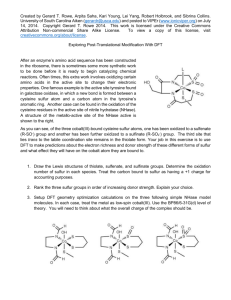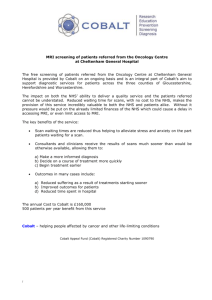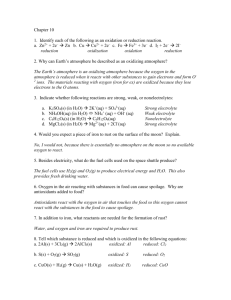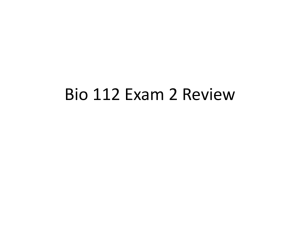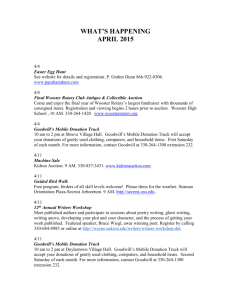Key of Reading Guide for Jones Paper
advertisement
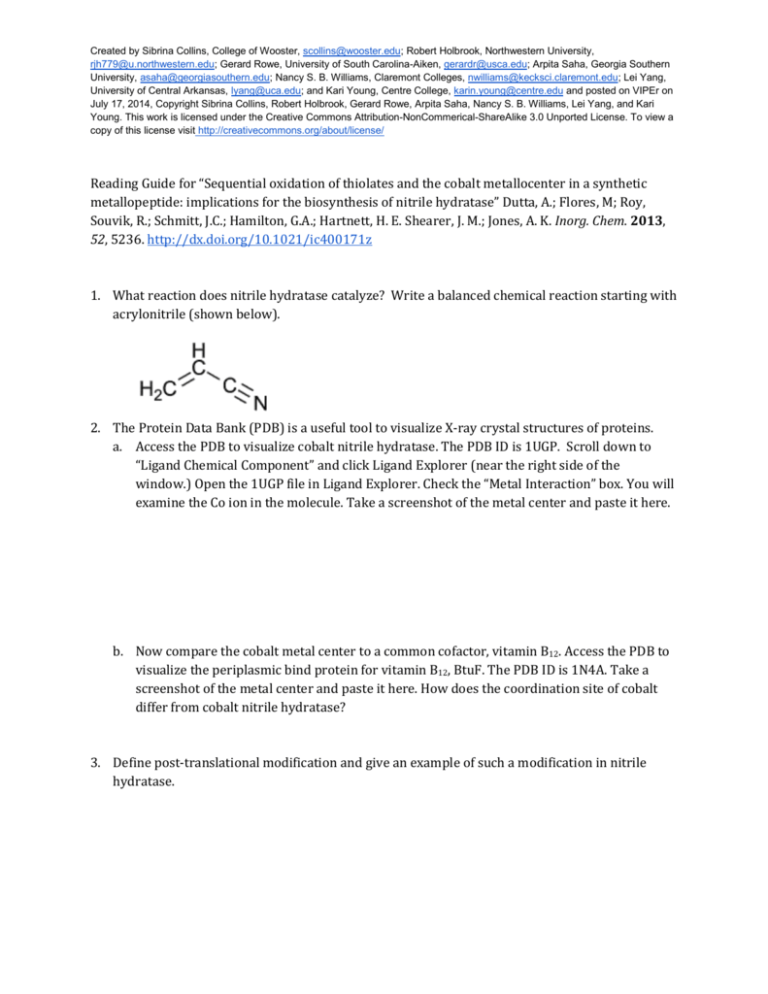
Created by Sibrina Collins, College of Wooster, scollins@wooster.edu; Robert Holbrook, Northwestern University, rjh779@u.northwestern.edu; Gerard Rowe, University of South Carolina-Aiken, gerardr@usca.edu; Arpita Saha, Georgia Southern University, asaha@georgiasouthern.edu; Nancy S. B. Williams, Claremont Colleges, nwilliams@kecksci.claremont.edu; Lei Yang, University of Central Arkansas, lyang@uca.edu; and Kari Young, Centre College, karin.young@centre.edu and posted on VIPEr on July 17, 2014, Copyright Sibrina Collins, Robert Holbrook, Gerard Rowe, Arpita Saha, Nancy S. B. Williams, Lei Yang, and Kari Young. This work is licensed under the Creative Commons Attribution-NonCommerical-ShareAlike 3.0 Unported License. To view a copy of this license visit http://creativecommons.org/about/license/ Reading Guide for “Sequential oxidation of thiolates and the cobalt metallocenter in a synthetic metallopeptide: implications for the biosynthesis of nitrile hydratase” Dutta, A.; Flores, M; Roy, Souvik, R.; Schmitt, J.C.; Hamilton, G.A.; Hartnett, H. E. Shearer, J. M.; Jones, A. K. Inorg. Chem. 2013, 52, 5236. http://dx.doi.org/10.1021/ic400171z 1. What reaction does nitrile hydratase catalyze? Write a balanced chemical reaction starting with acrylonitrile (shown below). 2. The Protein Data Bank (PDB) is a useful tool to visualize X-ray crystal structures of proteins. a. Access the PDB to visualize cobalt nitrile hydratase. The PDB ID is 1UGP. Scroll down to “Ligand Chemical Component” and click Ligand Explorer (near the right side of the window.) Open the 1UGP file in Ligand Explorer. Check the “Metal Interaction” box. You will examine the Co ion in the molecule. Take a screenshot of the metal center and paste it here. b. Now compare the cobalt metal center to a common cofactor, vitamin B12. Access the PDB to visualize the periplasmic bind protein for vitamin B12, BtuF. The PDB ID is 1N4A. Take a screenshot of the metal center and paste it here. How does the coordination site of cobalt differ from cobalt nitrile hydratase? 3. Define post-translational modification and give an example of such a modification in nitrile hydratase. Created by Sibrina Collins, College of Wooster, scollins@wooster.edu; Robert Holbrook, Northwestern University, rjh779@u.northwestern.edu; Gerard Rowe, University of South Carolina-Aiken, gerardr@usca.edu; Arpita Saha, Georgia Southern University, asaha@georgiasouthern.edu; Nancy S. B. Williams, Claremont Colleges, nwilliams@kecksci.claremont.edu; Lei Yang, University of Central Arkansas, lyang@uca.edu; and Kari Young, Centre College, karin.young@centre.edu and posted on VIPEr on July 17, 2014, Copyright Sibrina Collins, Robert Holbrook, Gerard Rowe, Arpita Saha, Nancy S. B. Williams, Lei Yang, and Kari Young. This work is licensed under the Creative Commons Attribution-NonCommerical-ShareAlike 3.0 Unported License. To view a copy of this license visit http://creativecommons.org/about/license/ 4. The “ligand” in this paper is a polypeptide called SODA with the sequence ACDLPCG (drawn below). Circle the atoms that are suggested to bind to Co(II). Put square boxes around other possible atoms that could bind to the metal center. 5. Examine the three structures in Scheme 1 of the paper and complete the following chart. Ligand charge Reduced Partially oxidized Fully oxidized Metal delectron count Draw the crystal field diagram and fill in electrons. Created by Sibrina Collins, College of Wooster, scollins@wooster.edu; Robert Holbrook, Northwestern University, rjh779@u.northwestern.edu; Gerard Rowe, University of South Carolina-Aiken, gerardr@usca.edu; Arpita Saha, Georgia Southern University, asaha@georgiasouthern.edu; Nancy S. B. Williams, Claremont Colleges, nwilliams@kecksci.claremont.edu; Lei Yang, University of Central Arkansas, lyang@uca.edu; and Kari Young, Centre College, karin.young@centre.edu and posted on VIPEr on July 17, 2014, Copyright Sibrina Collins, Robert Holbrook, Gerard Rowe, Arpita Saha, Nancy S. B. Williams, Lei Yang, and Kari Young. This work is licensed under the Creative Commons Attribution-NonCommerical-ShareAlike 3.0 Unported License. To view a copy of this license visit http://creativecommons.org/about/license/ 6. Which techniques were used to confirm the coordination geometry of reduced metallopeptide, partially oxidized metallopeptide, and fully oxidized metallopeptide? 7. Which techniques were used to confirm the oxidation state of cobalt in the reduced metallopeptide, partially oxidized metallopeptide, and fully oxidized metallopeptide? 8. X-ray absorption near edge structure (XANES) is a spectroscopic technique that can yield information about the oxidation state of a probed element through the excitation of a core electron. a. Fill in the table below with data from the paper. What is the oxidation state of cobalt in the reduced metallopeptide, partially oxidized metallopeptide, and fully oxidized metallopeptide? What are the K-edge energies for the Co edge for each sample? Cobalt oxidation state K-edge energy (eV) Reduced Partially oxidized Fully oxidized b. Rationalize the trend in K-edge energy as it relates to oxidation state of cobalt. Created by Sibrina Collins, College of Wooster, scollins@wooster.edu; Robert Holbrook, Northwestern University, rjh779@u.northwestern.edu; Gerard Rowe, University of South Carolina-Aiken, gerardr@usca.edu; Arpita Saha, Georgia Southern University, asaha@georgiasouthern.edu; Nancy S. B. Williams, Claremont Colleges, nwilliams@kecksci.claremont.edu; Lei Yang, University of Central Arkansas, lyang@uca.edu; and Kari Young, Centre College, karin.young@centre.edu and posted on VIPEr on July 17, 2014, Copyright Sibrina Collins, Robert Holbrook, Gerard Rowe, Arpita Saha, Nancy S. B. Williams, Lei Yang, and Kari Young. This work is licensed under the Creative Commons Attribution-NonCommerical-ShareAlike 3.0 Unported License. To view a copy of this license visit http://creativecommons.org/about/license/ 9. Why did the authors use negative mode ESI-MS to test the reduced Co-SODA? Why did the authors simulate the ESI-MS clusters (supporting information Figure S1)? 10. What is the magnetic susceptibility of the reduced Co-SODA complex? What information is revealed by this measurement? 11. How does the IR spectroscopy measurement support the assignment of the coordination sphere of the cobalt(II) center? 12. The UV-vis absorbance bands at 725 nm, 681 nm, and 609 nm are assigned as ligand field (or dd) transitions. How did the authors make this assignment? Created by Sibrina Collins, College of Wooster, scollins@wooster.edu; Robert Holbrook, Northwestern University, rjh779@u.northwestern.edu; Gerard Rowe, University of South Carolina-Aiken, gerardr@usca.edu; Arpita Saha, Georgia Southern University, asaha@georgiasouthern.edu; Nancy S. B. Williams, Claremont Colleges, nwilliams@kecksci.claremont.edu; Lei Yang, University of Central Arkansas, lyang@uca.edu; and Kari Young, Centre College, karin.young@centre.edu and posted on VIPEr on July 17, 2014, Copyright Sibrina Collins, Robert Holbrook, Gerard Rowe, Arpita Saha, Nancy S. B. Williams, Lei Yang, and Kari Young. This work is licensed under the Creative Commons Attribution-NonCommerical-ShareAlike 3.0 Unported License. To view a copy of this license visit http://creativecommons.org/about/license/ 13. Draw the Lewis structures of thiolate, sulfenate, and sulfinate groups. a. Rank order these from least oxidized to most oxidized sulfur. It may help to assign the oxidation state of sulfur using the oxidation number method. You can assume the oxidation number of an adjacent carbon atom is +1. b. How does donor ability change as sulfur is oxidized? 14. One possible mechanism for the action of nitrile hydratase is the activation of a water molecule by the Co(III) center to become a nucleophilic hydroxide ion. A notable difference between the active enzyme and the inactive metallopeptide model complex is the presence of an additional cysteine thiolate ligand trans to a putative water-binding site. a. How would the addition of a cysteine thiolate to the model complex change the rate of dissociation of a bound hydroxide ion from the cobalt center? b. How would the addition of a cysteine thiolate change the redox potential of the Co(II) metal center?
